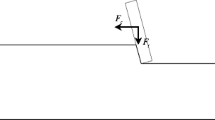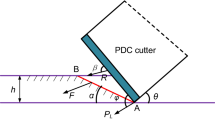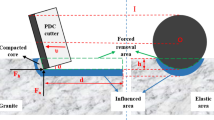Abstract
In order to achieve efficiently the optimal design and evaluation of PDC (polycrystalline diamond compact) bit, a finite element model for PDC bit cutting rock was established, forecasting the torque and the drilling pressure distribution trends of the cutting teeth on the bit. Through the PDC bit drilling rock, our experimental model validates the reasonableness and effectiveness of finite element simulation. It further demonstrates that the results of the changing trend of experiment and finite element simulation are very close and verify the accuracy and feasibility of the simulation model. The finite element model for single wing PDC cutting rock was established. This paper analyzes the distribution trends of the cutter torque and drilling pressure on bit under the conditions of the different penetration rates and rotational speeds. The “attack” of the cutting teeth is also analyzed. The results show that the torque of the cutting teeth is increased with the increasing penetration rate with the other conditions being the same. Under the same penetration rate and rotating speed, the drilling pressure of the cutting teeth tends to increase first with the increasing distance from the center axis of the drill bit, and then decrease. The cutting force of each tooth increases with the increasing penetration rate, and near the shoulder, it reaches the maximum, even though the cutting force is less affected by the rotating speed.















Similar content being viewed by others
References
G. Zhang, Study on rock breaking mechanism and state identification technology of rock PDC [D], China University of Mining and Technology, 2015.
M. Zhao, PDC drilling parameters optimization model and Application Research [D], Daqing Petroleum Institute, 2003.
X. Zhu, H. Li, Numerical simulation of cutting efficiency of cutting teeth in PDC. J. Appl. Sci. Eng. 01, 182–191 (2015)
T. Richard, C. Coudyzer, S. Desmette, Influence of groove geometry and cutter inclination in rock cutting[C]. 44th US Rock Mechanics Symposium and 5th US-Canada Rock Mechanics Symposium, American Rock Mechanics Association, 2010.
Y. Zhou, Z. Wang, Study on the effect of cutting angle on the rock breaking effect in the cutting angle of PDC bit cutting. Coal Mine Mach. 08, 49–51 (2009)
T.O. Pryhorovska, S.S. Chaplinskiy, I.O. Kudriavtsev, Finite element modelling of rock mass cutting by cutters for PDC drill bits. Pet Explor. Dev. 42(6), 888–892 (2015)
S. Yang, Development of conical PDC teeth and evaluation of laboratory tests for. Pet. Field Mach. 06, 38–42 (2015)
G. Hareland, R. Nygaard, W. Yan et al., Cutting efficiency of a single PDC cutter on hard rock. J. Can. Pet. Technol. 48(06), 60–65 (2009)
B. Akbari, S.Z. Miska, M. Yu, et al., The effects of size, Chamfer geometry, and Back Rake angle on frictional response of PDC cutters[C]. 48th US Rock Mechanics/Geomechanics Symposium, American Rock Mechanics Association, 2014.
P. Ju, Z. Wang, Y. Zhai et al., Numerical simulation study on the optimization design of the crown shape of PDC drill bit. J. Pet. Explor. Prod. Technol. 4(4), 343–350 (2014)
H. Cai, Optimization of key design parameters of PDC bit [D], China University of Petroleum, 2008.
H. Zhu, Q. Liu, J. Deng, The fracture mechanism of rock under the condition of drilling and rotary drilling. J. Appl. Sci. Eng. 04, 622–631 (2012)
X. Dong, J. Xiong, G. Wang, Numerical simulation of breaking rock mechanism of oscillation. J. Southwest Pet. Univ. Nat. Sci. Ed. 36(06), 160–167 (2014)
Q. Zhang, D. Li, W. Jing, S. Hu, PDC drill bit single tooth “attack” cloth tooth research and finite element analysis. Pet. Mach. 10, 5–8 (2014)
Author information
Authors and Affiliations
Corresponding author
Rights and permissions
About this article
Cite this article
Kuang, Y., Zhang, M., Feng, M. et al. Simulation and Experimental Research of PDC Bit Cutting Rock. J Fail. Anal. and Preven. 16, 1101–1107 (2016). https://doi.org/10.1007/s11668-016-0188-9
Received:
Published:
Issue Date:
DOI: https://doi.org/10.1007/s11668-016-0188-9




